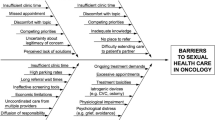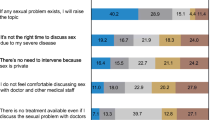ABSTRACT
BACKGROUND
Providers need an accurate sexual history for appropriate screening and counseling, but data on the patient, visit, and physician factors associated with sexual history-taking are limited.
OBJECTIVES
To assess patient, resident physician, and visit factors associated with documentation of a sexual history at health care maintenance (HCM) visits.
DESIGN
Retrospective cross-sectional chart review.
PARTICIPANTS
Review of all HCM clinic notes (n = 360) by 26 internal medicine residents from February to August of 2007 at two university-based outpatient clinics.
MEASUREMENTS
Documentation of sexual history and patient, resident, and visit factors were abstracted using structured tools. We employed a generalized estimating equations method to control for correlation between patients within residents. We performed multivariate analysis of the factors significantly associated with the outcome of documentation of at least one component of a sexual history.
KEY RESULTS
Among 360 charts reviewed, 25% documented at least one component of a sexual history with a mean percent by resident of 23% (SD = 18%). Factors positively associated with documentation were: concern about sexually transmitted infection (referent: no concern; OR = 4.2 [95% CI = 1.3–13.2]); genitourinary or abdominal complaint (referent: no complaint; OR = 4.3 [2.2–8.5]); performance of other HCM (referent: no HCM performed; OR = 3.2 [1.5–7.0]), and birth control use (referent: no birth control; OR = 3.0 [1.1, 7.8]). Factors negatively associated with documentation were: age groups 46–55, 56–65, and >65 (referent: 18–25; ORs = 0.1, 0.1, and 0.2 [0.0–0.6, 0.0–0.4, and 0.1–0.6]), and no specified marital status (referent: married; OR = 0.5 [0.3–0.8]).
CONCLUSIONS
Our findings highlight the need for an emphasis on documentation of a sexual history by internal medicine residents during routine HCM visits, especially in older and asymptomatic patients, to ensure adequate screening and counseling.

Similar content being viewed by others
References
Education and treatment in human sexuality: the training of health professionals. Report of a WHO meeting. World Health Organ Tech Rep Ser. 1975;(572):5–33.
Loeb DF, Aagaard EM, Cali SR, Lee RS. Modest impact of a brief curricular intervention on poor documentation of sexual history in university-based resident internal medicine clinics. J Sex Med. Jun 17 2010.
United States. Agency for Healthcare Research and Quality., US Preventive Services Task Force. Guide to clinical preventive services, 2005: recommendations of the US Preventive Services Task Force. [Washington, DC]: Agency for Healthcare Research and Quality; 2005.
Workowski KA, Berman SM. Sexually transmitted diseases treatment guidelines. MMWR Recomm Rep. 2006;55(RR-11):1–94.
Meyers D, Wolff T, Gregory K, et al. USPSTF recommendations for STI screening. Am Fam Physician. 2008;77(6):819–824.
Boulware LEBG, Wilson RF, Phillips K, Maynor K, Hwang C, Marinopoulos S, Merenstein DR-MP, Bass EB, Powe NR, Daumit GL. Value of the Periodic Health Evaluation. Evidence Report/Technology Assessment No. 136. (Prepared by The Johns Hopkins University Evidence-based Practice Center under Contract No. 290-02-0018). Rockville, MD:2006.
Boekeloo BO, Marx ES, Kral AH, Coughlin SC, Bowman M, Rabin DL. Frequency and thoroughness of STD/HIV risk assessment by physicians in a high-risk metropolitan area. Am J Public Health. 1991;81(12):1645–1648.
Lewis CE, Freeman HE. The sexual history-taking and counseling practices of primary care physicians. West J Med. 1987;147(2):165–167.
Platano G, Margraf J, Alder J, Bitzer J. Frequency and focus of sexual history taking in male patients–a pilot study conducted among Swiss general practitioners and urologists. J Sex Med. 2008;5(1):47–59.
Wimberly YH, Hogben M, Moore-Ruffin J, Moore SE, Fry-Johnson Y. Sexual history-taking among primary care physicians. J Natl Med Assoc. 2006;98(12):1924–1929.
Tao G, Irwin KL, Kassler WJ. Missed opportunities to assess sexually transmitted diseases in US adults during routine medical checkups. Am J Prev Med. 2000;18(2):109–114.
Curtis JR, Paauw DS, Wenrich MD, Carline JD, Ramsey PG. Internal medicine residents’ skills at identification of HIV-risk behavior and HIV-related disease. Acad Med. 1994;69(10 Suppl):S45–S47.
Ross PE, Landis SE. Development and evaluation of a sexual history-taking curriculum for first- and second-year family practice residents. Fam Med. 1994;26(5):293–298.
Rosen R, Kountz D, Post-Zwicker T, Leiblum S, Wiegel M. Sexual communication skills in residency training: the Robert Wood Johnson model. J Sex Med. 2006;3(1):37–46.
Temple-Smith M, Hammond J, Pyett P, Presswell N. Barriers to sexual history taking in general practice. Aust Fam Physician. 1996;25(9 Suppl 2):S71–S74.
Verhoeven V, Bovijn K, Helder A, et al. Discussing STIs: doctors are from Mars, patients from Venus. Fam Pract. 2003;20(1):11–15.
Burd ID, Nevadunsky N, Bachmann G. Impact of physician gender on sexual history taking in a multispecialty practice. J Sex Med. 2006;3(2):194–200.
Maheux B, Haley N, Rivard M, Gervais A. Do women physicians do more STD prevention than men? Quebec study of recently trained family physicians. Can Fam Physician. 1997;43:1089–1095.
Powderly WG, Mayer KH. Centers for Disease Control and Prevention revised guidelines for human immunodeficiency virus (HIV) counseling, testing, and referral: targeting HIV specialists. Clin Infect Dis. 2003;37(6):813–819.
Haist SA, Griffith IC, Hoellein AR, Talente G, Montgomery T, Wilson JF. Improving students’ sexual history inquiry and HIV counseling with an interactive workshop using standardized patients. J Gen Intern Med. 2004;19(5 Pt 2):549–553.
Zeger SL, Liang KY. Longitudinal data analysis for discrete and continuous outcomes. Biometrics. 1986;42(1):121–130.
O’Keefe R, Tesar CM. Sex talk: what makes it hard to learn sexual history taking? Fam Med. 1999;31(5):315–316.
Lindau ST, Schumm LP, Laumann EO, Levinson W, O’Muircheartaigh CA, Waite LJ. A study of sexuality and health among older adults in the United States. N Engl J Med. 2007;357(8):762–774.
Bachmann GA, Leiblum SR, Grill J. Brief sexual inquiry in gynecologic practice. Obstet Gynecol. 1989;73(3 Pt 1):425–427.
HIV Surveillance Report, 2008. Centers for Disease Control and Prevention; 2010.
St Lawrence JS, Montano DE, Kasprzyk D, Phillips WR, Armstrong K, Leichliter JS. STD screening, testing, case reporting, and clinical and partner notification practices: a national survey of US physicians. Am J Public Health. 2002;92(11):1784–1788.
Tsimtsiou Z, Hatzimouratidis K, Nakopoulou E, Kyrana E, Salpigidis G, Hatzichristou D. Predictors of physicians’ involvement in addressing sexual health issues. J Sex Med. 2006;3(4):583–588.
Shindel AW, Ando KA, Nelson CJ, Breyer BN, Lue TF, Smith JF. Medical student sexuality: how sexual experience and sexuality training impact US and Canadian medical students’ comfort in dealing with patients’ sexuality in clinical practice. Acad Med. 2010;85(8):1321–1330.
Goulet F, Jacques A, Gagnon R, Racette P, Sieber W. Assessment of family physicians’ performance using patient charts: interrater reliability and concordance with chart-stimulated recall interview. Eval Health Prof. 2007;30(4):376–392.
Chisholm CD, Weaver CS, Whenmouth LF, Giles B, Brizendine EJ. A comparison of observed versus documented physician assessment and treatment of pain: the physician record does not reflect the reality. Ann Emerg Med. 2008;52(4):383–389.
Adams AS, Soumerai SB, Lomas J, Ross-Degnan D. Evidence of self-report bias in assessing adherence to guidelines. Int J Qual Health Care. 1999;11(3):187–192.
Gordon NP, Hiatt RA, Lampert DI. Concordance of self-reported data and medical record audit for six cancer screening procedures. J Natl Cancer Inst. 1993;85(7):566–570.
Holmboe ES, Hawkins RE. Methods for evaluating the clinical competence of residents in internal medicine: a review. Ann Intern Med. 1998;129(1):42–48.
Gruber T, Sharma A, Daneschvar H, Estfan B. The Hawthorne effect in the assessment of pain by house staff. Am J Hosp Palliat Care. 2003;20(3):231–234.
Acknowledgments
This study was funded by the University of Colorado Division of General Internal Medicine Small Grants program. Danielle Loeb, MD, receives salary support through the University of Colorado Primary Care Research Fellowship funded by Health Resources and Services Administration. Ingrid Binswanger, MD, MPH, is supported by the Robert Wood Johnson Physician Faculty Scholars Program, by the National Institute on Drug Abuse (1R03DA029448-01), and by the Agency for Health Care Research and Quality (AHRQ K12 HS019464). We also received support for statistical services from the Colorado Health Outcomes Program. The content is solely the responsibility of the authors and does not necessarily represent the official views of any of the funders.
Prior Presentations
The findings from this study were presented at the Society of General Internal Medicine Annual Meeting in Minneapolis, MN, in 2010.
Conflict of Interest
None disclosed.
Author information
Authors and Affiliations
Corresponding author
Appendix A: Chart Abstraction Tool
Appendix A: Chart Abstraction Tool
Items reviewed | Variable type/options | |
1. | Number of active problems | # |
2. | Number of problems addressed at visit | # |
3. | Any genitourinary (M or F) complaint/lower abdominal pain in female? (Include erectile dysfunction) | Yes/no (Y/N) |
4. | Patient concern about sexually transmitted infection (STI) or human immunodeficiency virus (HIV)? | Y/N |
5. | Carry diagnosis of chronic pain? (low back pain, pelvic pain, abdominal pain, chronic pain syndrome, or other)? | Y/N, specify (from list) |
6. | On chronic narcotics (not acute)? | Y/N |
7. | Treatment for erectile dysfunction in medication list? | Y/N |
8. | Method of birth control—specify type? | OCP or patch/condom/hysterectomy/tubal, vasectomy/Depo-Provera/Nuvaring/not specified |
9. | Primary language/language other than English? | Y/N (English speaker)/not Specified |
9a. Who interpreting if not English | If yes, family/friend/interpreter/phone interpreter/not specified | |
10. | Any physical restrictions/ (i.e., paraplegia, wheelchair, walker, cane) | Paraplegia/wheelchair/walker/cane/not mentioned/no restrictions |
11. | Any developmental disability | Y/N |
11a. If so, what? | Moderate/severe (functioning independently or not) | |
12. | Marital status | Long-term partner/ single/ married/ divorced/ widowed/not specified |
13. | Recent death of spouse? (within last year) | Y/not Specified |
14. | Recent divorce/break-up? (within last year) | Y/not Specified |
15. | Sexual orientation (if mentioned) | Heterosexual/homosexual/bisexual/not mentioned |
16. | HIV status (if mentioned) | Y/not specified |
17. | Other health care maintenance (HCM) performed? (Y/N) | Y/N |
16a: Which HCM discussed (colon, breast, cervical, immunizations, cardiovascular risk, etc.) | Specify/lipids or blood pressure as cardiovascular risk, colon, breast, cervical, immunizations, DEXA = bone density. Basic metabolic panel (BMP), or chem. 7 or fasting glucose or DM as diabetes screen (not disease); ignore tobacco cessation/eye check | |
18. | History of prostate cancer? | Y/not mentioned |
19. | Diagnosis of dementia? | Y/not mentioned, Alzheimer’s, vascular, Parkinsonian |
20. | Diagnosis of mental illness? (Depression, bipolar, anxiety, schizoaffective) | Y/not mentioned, depression, bipolar, anxiety, personality disorder, schizophrenia, eating disorder, OCD, schizoaffective disorder, and other |
21. | Type of visit (per MA) | See below |
22 | Type of visit (per provider) | See below |
Rights and permissions
About this article
Cite this article
Loeb, D.F., Lee, R.S., Binswanger, I.A. et al. Patient, Resident Physician, and Visit Factors Associated with Documentation of Sexual History in the Outpatient Setting. J GEN INTERN MED 26, 887–893 (2011). https://doi.org/10.1007/s11606-011-1711-z
Received:
Revised:
Accepted:
Published:
Issue Date:
DOI: https://doi.org/10.1007/s11606-011-1711-z




